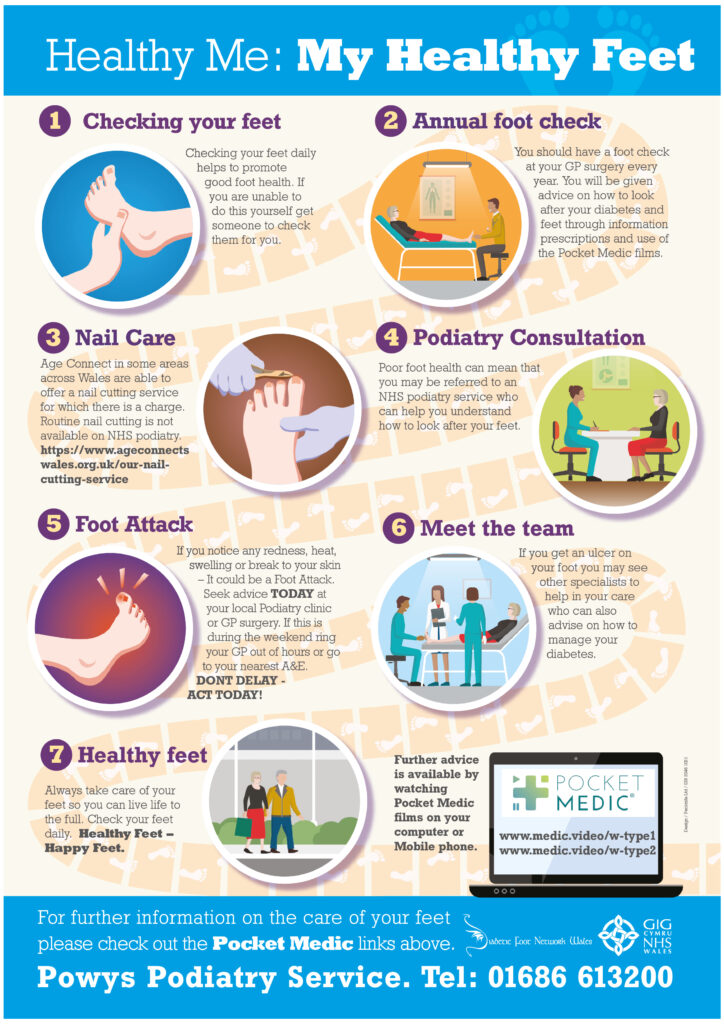
Foot care guidelines
Co-operative Working
Aim
To improve knowledge and awareness in essential foot care for people living with Diabetes.
Objectives:
To enable the carer to:
- recognise foot problems which require referral to other agencies
- demonstrate foot care to the person with diabetes (in order that they can carry out their own personal social care) if they are able to
- educate them in foot care to enable them to carry out their own personal social care where appropriate
- provide advice on hosiery and footwear
- recognise foot problems which require referral to a GP and/or a Health Professional Council (HCPC) Registered Podiatrist – Private or NHS
Bathing
- Feet should be washed daily, this helps to keep them clean and prevent and identify any changes or problems
- Use mild soap and luke warm water (check water temperature). Some people may have loss of sensation in their feet and may not be able to tell whether the water is too hot, only realising the water is too hot when the skin is burnt or touches an area that has sensation
- Rinse feet thoroughly
- Do not soak feet for longer than 5 minutes. Soaking feet for longer than 5 minutes can cause the skin to become soggy and fragile (Figure 1)
- Dry carefully especially between toes
Figure 1
Make sure between the toes are dried after washing and don’t apply cream between the toes as it can make the skin macerated and peel and more prone to fungal infections.
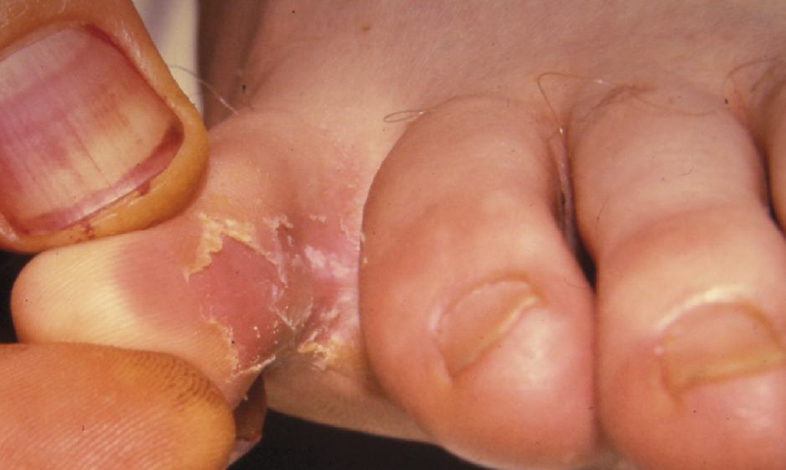
Dry skin
Moist skin
Dry skin can be fragile and more likely to be damaged. Looking after foot skin can help prevent problems, including breaks in the skin.
- A moisturising/emollient cream should be applied daily
- Do not apply the cream between toes (figure 1)
- A foot cream containing Urea, will help to moisturise dry hard skin or cracked heels (figure 2)
Figure 2
Dry cracked heels can be managed by using a foot cream containing Urea daily. Some people like to put it on at night and a pair of cotton socks over to help it soak in.
- Alternatively, foot moisturiser can be purchased in local pharmacies/ supermarkets
- Corn plasters and safety blades should be avoided. They are likely to cause harm
Sweaty skin can become fragile and more likely to be damaged. Keeping feet dry and clean can help prevent problems, including breaks in the skin (Figure 1).
- Sweaty feet may be dabbed with cotton wool moistened with surgical spirit
- Talc can be applied sparingly on sweaty skin for those who use these powders. Although, try and avoid it clogging between the toes
- If using talc, the feet must be washed and dried daily especially between the toes
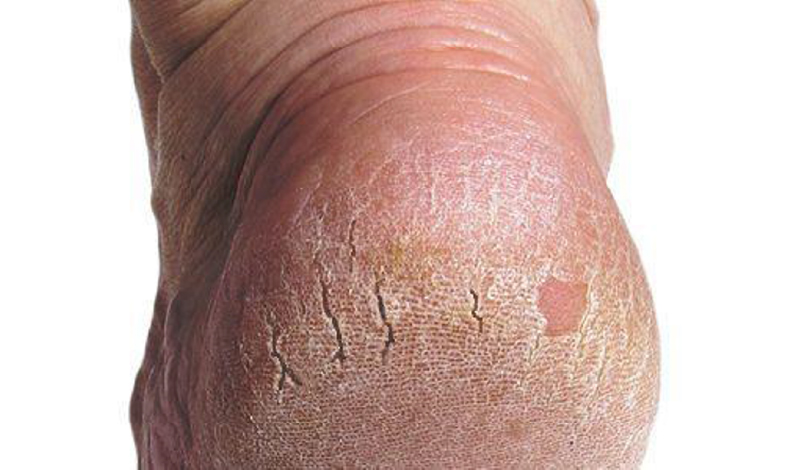
Nail care
Nails can become thick and hard as we get older or if they have been damaged. Attempting to cut the nails can cause trauma to the skin and should be avoided (figure 3).
- Filing the nails weekly is a safe way to manage the nails without causing trauma to the skin
- Using an emery board weekly and filing the nails while they are dry can keep the nails short and manageable
- If the person with diabetes can reach their feet safely, they should be encouraged to file their nails weekly or perhaps a family member can help them
- Alternatively, a HCPC registered Podiatrist can provide further advice.
Looking after your feet
Understanding feet
Care of the High Risk Foot
Podiatrist working in the NHS are registered with their governing body the hcpc (Health & Care Professions Council) ensuring they meet National Standards. They are then able to use these initials to indicate the level of training they have achieved.
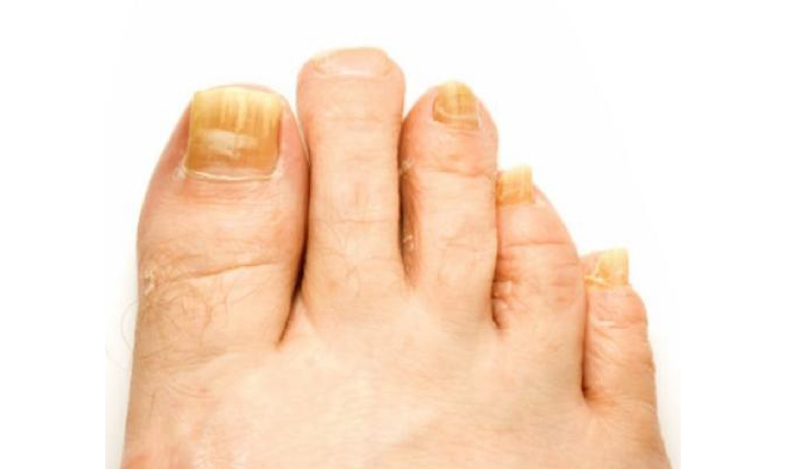
Nail tufts
Wounds and abrasions
Nail tufts are small protrusions of the nail bed
found on the underside of the nail which are
rich in blood vessels
- It is preferable to use a nail file to avoid causing trauma to the nail tuft
- Should this occur the toe must be dressed as for any wound or abrasion and monitored
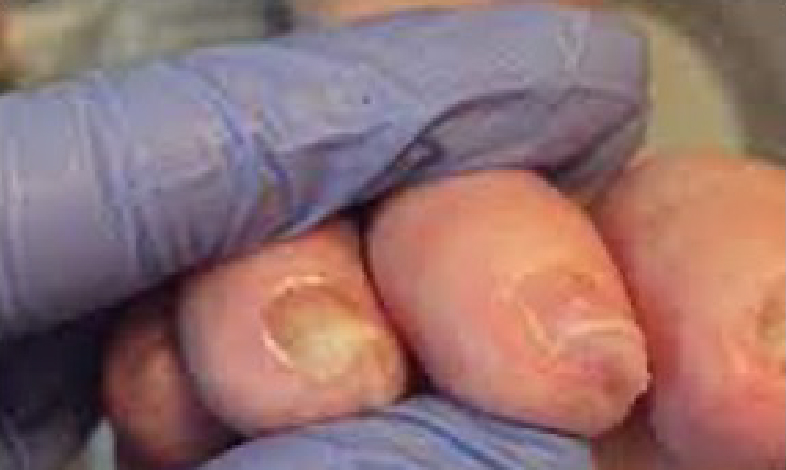
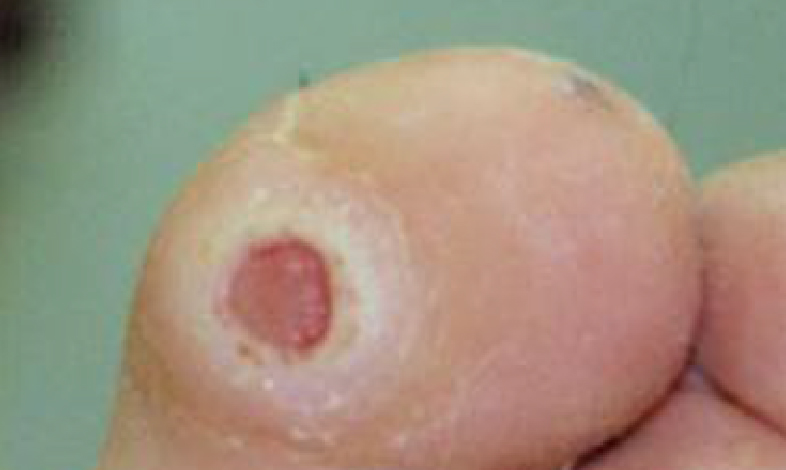
- Blisters, splits, cracks or fissures, cuts and grazes and other minor skin breaks should gently and carefully be cleaned with tap water only and a clean dry wound dressing applied
- All breaks in the skin must be kept dry, monitored every 1-2 days and must not be neglected. Small superficial grazes or cuts should be expected to heal in a few days
- Any cuts, grazes, ulcers, infected areas or wounds that are slow to heal must be referred to a District Nurse, the client’s GP or a HCPC registered Podiatrist (Figure 4).
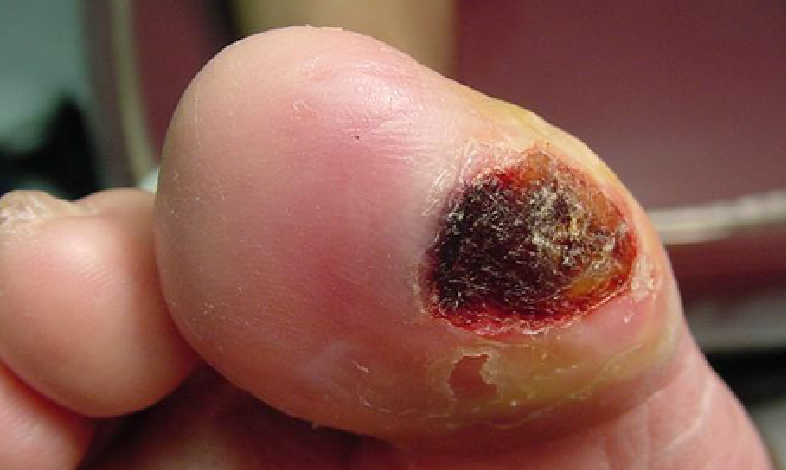
Figure 4
These are wounds on the big toes; they may have started with a small cut or blister but have not healed. If a small cut is taking more than a couple of days to heal please follow the advice above, seek medical advice from HCPC registered Podiatrist, GP or district nurse.
Danger/Warning Signs
Should any of the following signs or symptoms present then the nurse/carer needs to consider referral to a senior member of staff (if in care home) GP, HCPC Registered Podiatrist or District Nurse team.
Areas of:
- Pain, itching, throbbing, swelling, discolouration
- Changes in colour or temperature of the foot or leg
- Redness, heat, shininess or very white and cold areas
- Breaks in the skin (see notes on skin abrasions)
- Discharges of pus, blood or weeping
- Numbness or loss of sensation or function
- Corns, callouses or other skin lesions
- Thickened or misshaped nails
- In-growing toenails
Prevention of cross infection
Single use /or single person use to minimise cross infection risks
- Items used for a single individual need only routine disinfection between use, i.e. nail files. These can be purchased and disposed of after each use. Metal files
- (Diamond deb file) can be purchased and disinfected after each use
- Comprehensive hand washing is best practice to reduce cross infection risks for both carer and person being cared for
Hosiery – (socks and stockings)
- Socks, tights and stockings need to be changed and washed dail
- There should be enough room so that feet and toes are not cramped
- Tightly fitting socks and stocking tops restrict the circulation and are best avoided especially in the elderly or for anyone with poor circulation, poor sensation, swelling or poor tissue viability (fragile skin)
- Cotton and wool mixtures are often warmer than synthetic materials and do not cause problems with excessively sweaty feet Elastic stockings/support hose ideally should be put on first thing in the morning before the client gets out of bed if used to reduce swelling and must be correctly fitting Socks should be worn with all footwear including slippers
Footwear – advice on fitting (shoes, sandals and slippers)
All footwear should fit correctly
- Shoes are best bought in the morning or early afternoon since many feet swell up during the day. Shoes should be tried and fitted with the person standing (if able) and sitting. They should walk around the shop to allow the foot to rest in its natural position
- Feet need to be measured by a trained shoe fitter to ensure a proper fit as feet change shape and size over the years. Not all people with diabetes can feel their feet, so it’s hard to tell if the shoe is too small or too big
- Shoes must fit well, be broad fitting, have a deep and rounded toe area and have a fastening. Heel cup should fit securely but not too tight or loosely
- Shoes with laces or adjustable straps (Velcro or buckle) hold the shoe to the foot and stop the foot sliding forward inside the shoe (elastic laces are available for those unable to bend or tie them up)
- New shoes should not need to be ‘broken in’ but it is better to wear them for short periods at first and gradually increase the time the shoe is worn. Checking for any redness or signs of rubbing. If there are signs of the shoe rubbing, they should be discarded
- Shoes provide protection and support so look for firm non slip cushioned soles and soft supple uppers of leather or fabric
Footwear – general advice
- Where possible avoid wearing the same shoes for too long at a time and air them well between use to dry them out
- It is advisable to have two pairs of shoes and wear them on alternative days Closed-in footwear of manmade material can often cause excessive sweating (e.g. trainers/some slippers/wellingtons) and should be changed and aired frequently
For further advice on Footwear go to: https://www.healthy-footwear-guide.com/
Exercise and wellbeing
Where possible people with diabetes should be encouraged to exercise including their feet as this can assist in maintaining core stability and mobility. The below website (Dewis Cymru) can give further information on exercise classes in your area as well as advice and information on your wellbeing.

Wellbeing
Dewis Cymru is THE place to go if you want information or advice about your wellbeing –
or want to know how you can help somebody else.
When we talk about your well-being, we don’t just mean your health. We mean things like where you live, how safe and secure you feel, getting out and about, and keeping in touch with family and friends.
No two people are the same and well-being means different things to different people. So Dewis Cymru is here to help you find out more about what matters to you. You can access this information at www.dewis.wales.
We’ve got information that can help you think about what matters to you, and we’ve also got information about people and services in your area that can help you with the things that matter to you.
Co-operative working
The NHS Podiatry staff are happy to provide advice, guidance and support wherever this is required.
The Podiatry Service works closely with carers and people with diabetes to promote co-production to enhance good foot health in the population.

